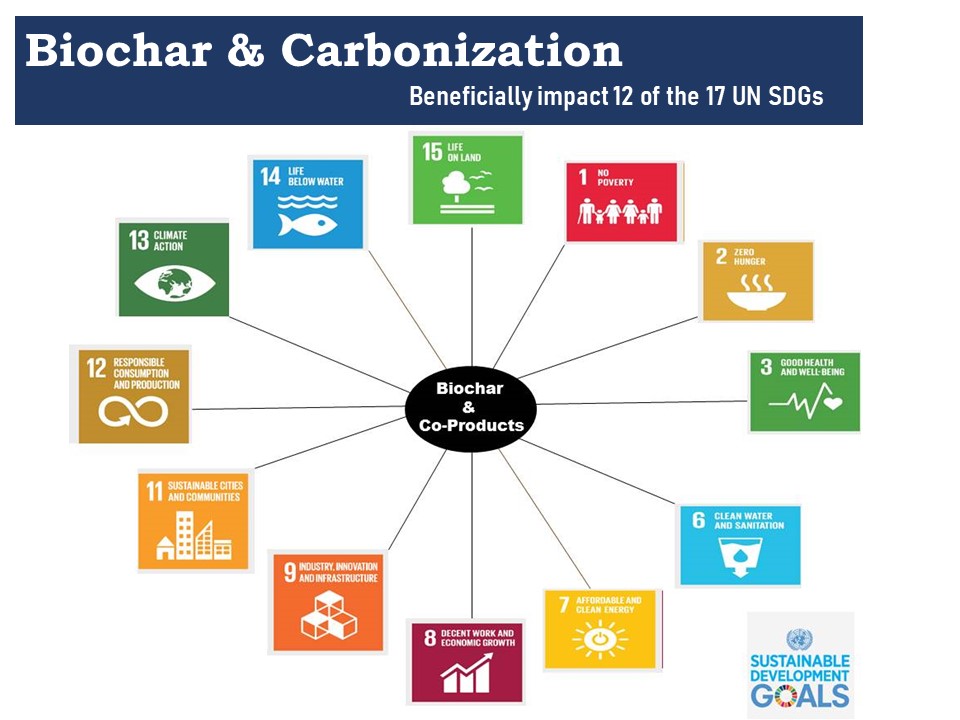
Two minutes. Two whole minutes to introduce biochar to United Nation’s delegates from around the globe. Far too little time but at least it was on the agenda of the 7th multi-stakeholder ‘Science, Technology and Innovation for the UN Sustainable Development Goals. Thematic session 5, the one I was asked to join as a ‘discussant’ (had to look up what that meant), was focused on ‘Emerging carbon dioxide removal (CDR) technologies for addressing climate change’.
In addition to a high level (very high level, remember two minutes!!) overview of your particular CDR, panelists and discussants were asked to address one of the five guiding questions used for the session which included:
- CDR technologies are needed at the local (industrial or power plant), national (NDC), and global scale (reaching net zero global emissions). What partnerships are best at each level?
- For companies and funders– how do you plan to scale up your technologies to make a difference at the global scale of 1-10Gt/yr?
- How can we better support the innovation ecosystem around these technologies?
- How can the UN contribute to a showcase of emerging demonstration projects and best deployment practices of CDR technologies?
- How can the UN contribute to a responsible discussion of the potential consequences, costs and trade-offs of various technologies, their interactions with various SDG goals, and their ethical and governance issues alongside conventional mitigation and adaptation strategies?
It’s always interesting to prepare for different audiences but being given such a short period of time, I had to hone my biochar ‘elevator pitch’ down to this:
Biochar is likely the oldest anthropogenic CDR solution yet few have ever even heard of it. Indigenous cultures across the globe figured out thousands of years ago how to carbonize biomass and fill it with nutrients to enrich soils and feed growing populations.
Biochar is safe, scalable and shovel-ready. It is already being produced by smallholder farmers in Africa, Asia and Latin America and it is being produced at industrial scale in Europe, China and North America.
Normally plants decompose and return all of their carbon to the atmosphere, but when heated using high temperatures and low oxygen through a process called pyrolysis, up to half of the carbon is converted into highly stable carbon that can last for centuries when deposited in soils or other long-lived products such as concrete or asphalt. It can also help reduce methane from livestock farming, landfills and even the oil and gas industry. It can immobilize heavy metals and other toxins in soils. It can harvest excess nutrients in contaminated water bodies. And it can help farmers and cities to both adapt to and reduce the impact of climate change while supporting 12 of the UN SDGs.
Importantly biochar may be able to help countries increase their climate ambition and we are building a standardized framework for countries to quantify how much carbon could be sequestered based on available, unused biomass which includes livestock manure, crop residues, disaster, demolition and forestry debris and even sewage sludge.
Given the huge appetite for carbon removal credits and the extremely limited supply, biochar production is scaling quickly to meet current demand while bringing needed revenues to smallholder farmers and other producers.
But we need your help to get the word out, to build markets for biochar, to showcase current projects or future possibilities, to secure funding for scaling and to encourage countries to develop biochar based decarbonization plans.
I would love to hear what others would focus on if only given two minutes!


Brilliant work again Kathleen, thank you for sharing it with me and any other who care for the future.
We recently won two awards during the 9th edition of “Premios Verdes” at Miami, FL on April 24th 2022 toward our project called ”Biochar & Energy for CO2 sequestration in soils” developed in Venezuela. Find out more on our website: http://www.ven.woodgas.com
Dear Kathleen, thank you very much for a great and important pitch. Would mind if I use the content and make it a post on our website and LinkedIn, off course quoting you as the source?
As we talked about in Bio360 in Nantes, we in WAI are addressing the metallurgical industries because of it’s enormous demand and workable business model. Unfortunately, we do not see any way in Norway (Scandinavia) we can establish production of say 20000 tons/year biochar for the agriculture markets. We have to produce Biocarbon, well aware that the benefits from using it as animal feed and putting it in the farmland would be so much larges. Thanks again Kathleen, hoping to hear from you.